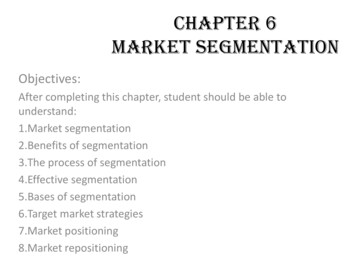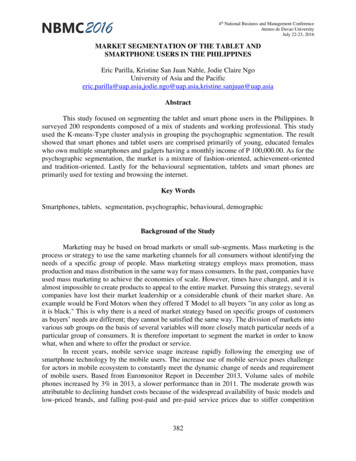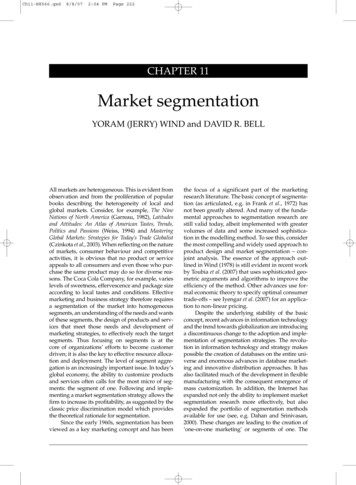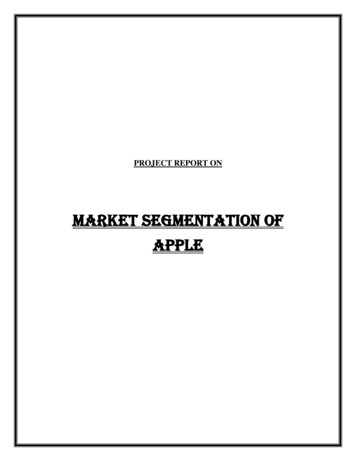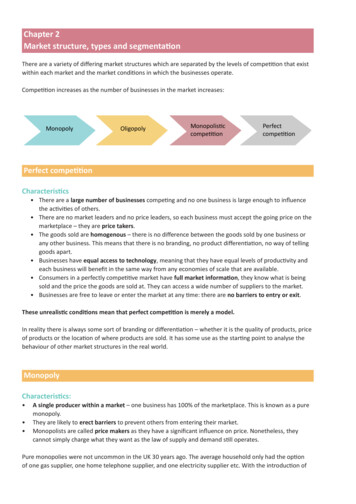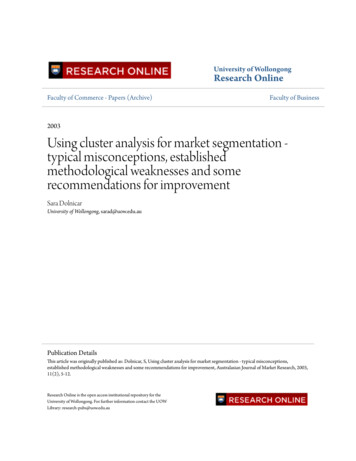
Transcription
Market SegmentationLecture 3Consumer Heterogeneity andFocusing Your Marketing Plan
Overview Target Markets Segmentation Strategies Market Segmentation1.Geographic segmentation2. Demographic segmentation3. Psychographic segmentation4. Product-related segmentation Segmentation Techniques General Consumer Behavior Constructs
What is a Market? Market: Group of people with sufficientpurchasing power, authority, and willingness to buy– An individual’s lifestyle, income, geographic location,age, and other factors all contribute to the likelihoodthat a person will buy certain products How do you determine if your good is part of amarket?– Cross price elasticities– Common sense of usage– Demand levelsMarket
What is a Target Market? Target market: Specified segment of consumersmost likely to purchase a particular product. You gain a competitive advantage with customers byfocusing your marketing efforts on your target. Do not let your target passively happen Choose!TargetMarketMarket
There is no prize forsecond place.
2 Examples1. Do not try to design THE CHIP2. Store Location
Target Markets All marketing efforts focus on target markets (the 4 P’s) Crucial: Before a marketing mix strategy can beimplemented, the marketer must identify, evaluate, andselect a target market Marketers must study a market to segment andcommunicate with it effectively– data analysis and promotion Allows firms to develop more efficient and effectivemarketing strategies The target market may be determined by operationalconsiderations– E.g. distribution constraints, competition, regulation– choose a target that you can service well
Choosing a Target An iterative process1. Product concept2. Hypothesize a suitable target3. Acquire market data (e.g. surveys)4. Refine marketing plan– product, product concept, 4 Ps5. Acquire market data (e.g. surveys)
Types of Markets Consumer products: Goods or services purchased by anultimate consumer for personal use Business products: Goods or services purchased for useeither directly or indirectly in the production of other goodsand services for resaleConsumers Customers The key to classification is to identify the purchaser and thereasons for buying the goods– Ex: Birds Eye segmented the retailer market and chose to sell only tosupermarkets, not smaller grocers and smaller freezer shops Downstream considerations, e.g. consumer demand, of course is a BIG partof retailers needs
Demand Is Not the Retailers Only NeedWine Shops and Expensive Wines Many wine shops will have a limitednumber of expensive wines along sidecommon wines The wine shop is not interested indemand for those wines Those wines are there to induceshoppers to upgrade from cheap winesto moderately priced wines
Demand Is Not the Retailers OnlyNeedWhole Foods and Junk Food Whole Foods has a marketing plan to brand itself aslooking out for your well being Even if your double fudge granola cookie will kill there,WF will not risk tarnishing its image Whole Foods greatest asset is its brand equityProduct Selection Often products are available as signals or to avoidalienating a segment over one item Ex: exotic fruits/produce may not sell well, but theymake people think the store is better
The Role of Market Segmentation Market Segmentation: Division of the totalmarket into smaller, relatively homogeneousgroups No single marketing mix can satisfy everyone– With one particular consumer, second place means nopurchase it is best to be very appealing to a subset ofthe market than be mediocre to all. Separate marketing mixes may be used for differentmarket segments
Who’s the Target?Diet CokeCoke Zero
Criteria for Useful Segmentation1. The market segments must be measurable in termsof both purchasing power and size– Otherwise the market would be ill-defined2. Marketers must be able to effectively promote andserve a market segment3. Market segments must be sufficiently large to bepotentially profitable4. The number of segments must match the firm’scapabilities5. Stable enough to be worth targeting over time
Segmentation Strategies1. Mass Marketing – treat the entire market as one big segment Good strategy when–consumer needs are homogenous–the market is small (segments would be too small)–differentiation of the product is difficult Still may require positioning within the market’s distribution Requires only 1 marketing mix Low cost way to produce and market products Ex: food staples (milk, rice, fresh produce) Becoming less common of a strategy–increased heterogeneity in consumer needs–expansion of markets–lower media and distribution costs
Segmentation Strategies2. Concentration Strategy – use only 1 marketingmix for 1 target segment Pros– Smaller focus allows smaller firms to compete withlarger firms– Production cost savings from specialization– Requires only 1 marketing mix Cons– Risky due to a lack of product portfolio diversification– If the target market changes in number orpreferences, then sales will drop
Segmentation Strategies3. Multi-segment Strategy - Use multiple marketing mixes totarget multiple target markets Pros––––Increased market coverageDiversified product (marketing mix) portfolio (less risk)Differential pricing maintainablePremiums can be levied from differentiating for each targetmarket (higher willingness to pay)– Changes in the target market may simply result in shifts toone of the other targets segment Cons– Expensive to maintain many market mixes– Production costs are higher– Cannibalism
Multi-Segment Strategy Example TaB Cola: launched by Coke in 1963 as a way totarget dieters (and compete with RC’s Diet Rite)– Coca-Cola was very protective of its brand identity;didn’t want to associate this product with Coke. Diet Coke: launched in 1982 to benefit Cokelabel– consumers rated the taste of Diet Coke higher if it wasin a bottle labeled “Diet Coke” versus “TaB” Coke Zero: launched in 2005 as a way to targetmale “dieters”– Marketing research found young males didn’t want tobe associated with “dieters”
Multi-Segments: Diet Coke vs Coke Zero Promotion:– Diet Coke: Taylor Swift– Coke Zero: Dude playing video games Product:– Diet Coke: Cheerful can– Coke Zero: Masculine black can Price:– both the same as regular Coke even though both are a lotcheaper to produce? Why? Distribution:– How do you think Diet Coke and Coke Zero’s availabilitydiffers?
Segmentation Strategies4. Customization Strategy – treat eachconsumer as a segment Costly to produce, promote, and distribute– direct to consumer distribution Requires a high level of customerinvolvement
Customization Strategy
Segmentation Strategies 5. Social Network Marketing
Social Network Strategy Sell through representatives who throw a party– Ex: Pampered Chef, Tupperware– Word-of-mouth endorsements are powerful– Makes buying a social obligation– Seller assumes the risks and promo costs Social Media Marketing– Target individuals on Facebook– Target influential “nodes” of social networks– Demo-, Geo-, Psycho-graphic, and usage patternsmay be shared or inferred. Allows accurate targeting
Segmenting Consumer Markets1. Geographic segmentation2. Demographic segmentation3. Psychographic segmentation4. Product-related segmentation
1. Geographic Segmentation
Geographic Segmentation Dividing an overall market into homogeneousgroups on the basis of their locations– Does not ensure that all consumers in a location willmake the same buying decision– Helps in identifying some general patterns Big (localized) populations allow for cost effectivemarketing (why?)– Lower promotional costs per customer– Lower distributional costs26
Geographic Segmentation Growing populations and economies provide strategicopportunities– Gain a competitive advantage by gaining high market share early– Gain first mover’s advantage. Why do they give a 1st movers an advantage? Geography can proxy for other variables– Businesses must also consider economic and cultural variables May combine their marketing efforts in countries thatshare similar characteristics– Luxury foods should first be marketed where there is a lot ofdisposable income– Similar tastes
Geographic Segmentation With post-WWII growth of suburbs, traditional cityboundaries have lost meaning for marketers Government now classifies urban data in severalcategories based on population size and characteristics The U.S. Bureau of Census classifies urban areas as:– Metropolitan Statistical Area (MSA) – General area aroundurban areas with 50,000 people– Micropolitan Statistical Area - 10,000-49,999 people– Core Based Statistical Area (CBSA) MSAs Micro SAs– Primary Metropolitan Statistical Area (PMSA) – groups ofadjacent counties with economic and social ties– Consolidated Metropolitan Statistical Area (CMSA) –28largest 25 urban areas
Using Geographic Segmentation Demand for some goods and services canvary according to the geographic region Most major brands get 40-80% of their salesfrom what are called core regions Climate is often an important geosegmenting factor– Ex: Summer foods may be marketed differentlyin the south29
Where would you sell these?
I scream, you scream, does everyonescream for ice cream?
People in the south scream at gasstations
2. Demographic Segmentation Dividing consumer groups according tocharacteristics such as age, sex, income,occupation, education, household size, andstage in the family life cycle A primary source for demographic data inthe U.S. is the U.S. Census Bureau– Census “Quick Facts” for 2009: Population 5 years old Population 18 years old Population 65 years old6.5%23.7%13.3%33
Cohort Effect The cohort effect: Tendency of generationmembers to be influenced and boundtogether by significant events in their lives.– formative years are most crucial: ages 17 to 22– think generations– NOT THE SAME AS AGE EFFECTS
Cohorts Baby boomers: WWII to early/mid 1960s– Approximately 78 million; lucrative, diverse segment that generallytends to value health and quality of life Generation X: Mid/late 1960s to 1979– Nearly 50 millions; family-oriented, well educated, and optimistic Generation Y (Millennials): Born in the early 1980s to mid 1990s– Children of baby boomers, approximately 71 million – confident,untrusting, career/achievement driven; “seen it all – know it all”;widespread feeling of entitlement. Not open to criticism Generation Z: Late-1990s to 2000s Double Rainbow OMG– Born after the web revolution – exposed to new forms ofcommunication and technologies (web, cell phones, twittering );approximately 74 millions; they will be the most educated, financiallywell-off (sons and daughters of gen X) – when approaching the jobmarket may lack interpersonal skills35
Campbell’s Go“Campbell is also pushing out a slew of digitalcontent to draw the attention of these [people]. Thenew line of soup, Campbell's Go, has Facebook andTumblr pages, as well as partnerships with BuzzFeedand Spotify that Campbell hopes will convey thepersonality of the soup and appeal to its targetaudience.”“Campbell Soup Company has launched a new line ofbold-flavored soups in microwaveable packaging andis trying to cultivate a whimsical, humorouspersonality for the line to attract Who?Millennials.
Segmenting by Age As people get older – they become less impulsive– they become more savvy when it comes to adsand gimmicks– they care about different things What?
School-Age Children Have significant influence over family purchases– 10 billion/yr. spent in marketing to children But these products must be jointly marketed to parents More than ½ of U.S. children born today are non-white Are impulsive– Will covet a product because of a cartoon character– Marketing practices of unhealthy options are under fire as obesity rates skyrocket Bright packaging is effective because all bright foods in nature arenutritious Barbara Rolls (here at PSU) is a pioneer in creating clever ways to getkids to eat better– Put air in food, putting veggies in other foods, etc Brian Wansink, a marketing researcher, is responsible for redesigningschool lunchrooms to get kids to eat better38
Segmenting by Age Tweens and Teens – spend 200 billionannually and influence billions of dollars offamily purchases– Mostly on junk food– Don’t know how to cook– What ate their needs? Middle Aged––––– 11 trillion spending power75% have Facebook pagesvalue health and quality of lifeless sensitive to food prices due to busy livesWhat are their needs?
Segmenting by Age Seniors – 40 million people, older than 65– control about three-quarters of the country’s totalassets– retirees spend more time preparing their own food– tend to be cautious, not 1st adopters– What are their needs?
Segmenting by Household Type Family Life Cycle Stages Segmentation– The process of family formation and dissolution Families form in 20’s and 30’s Then comes a very busy time period with childrenpresent (ave. age of mom when 1st child born 25.4) increasing (was 21 in 1970) Eventually households become “empty nests” aschildren leave– Life stage, not age, is the primary determinantof many consumer purchases– Ex: 40 yr old couple with 3 kids needs?41
Segmenting by Household Type Today’s U.S. households are very diverse– Greater opportunity for segmenting the marketand product differentiation– Many more single parent households More convenient. ready-to-eat meals– More young couples without children eat out more, spend more on luxury foods– More single person households more single person portioned foods
when time is mostvaluable/scarce
when it’s not worthlooking for a bargain
Segmenting by Gender 90% of food purchases are made by women!– Why women’s perspective dominates ads Marketers must ensure that traditionalassumptions are not false Marriage partners a
The Role of Market Segmentation . –Coca-Cola was very protective of its brand identity; didn’t want to associate this product with Coke. Diet Coke: launched in 1982 to benefit Coke label –consumers rated the taste of Diet Coke higher if it was in a bottle labeled “Diet Coke” versus “TaB” Coke Zero: launched in 2005 as a way to target male “dieters” –Marketing .


